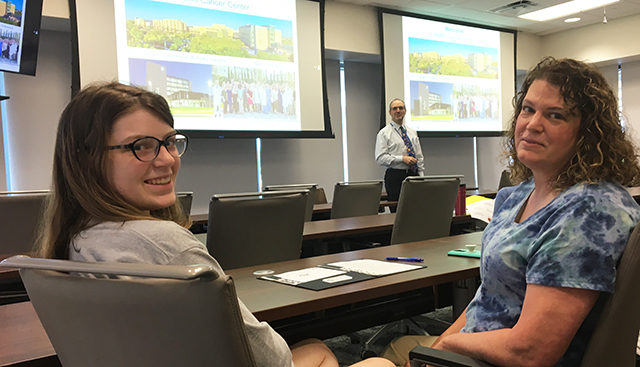Moffitt’s Melanoma Expertise Benefits Children, Too
Twelve-year-old Jackson Helms of Lithia doesn’t mind coming to Moffitt Cancer Center once a year. Usually, he’d be one of the youngest patients at the adult cancer center. But at Moffitt’s annual pediatric melanoma clinic, he’s in good company.
The annual clinic day held at the cancer center’s McKinley campus brought 15 young patients and their parents to see doctors in an atmosphere of balloon animals, therapy dogs, cookies and finger paints.
“Pediatric melanoma isn’t the most common thing you see,” said Dr. Jane Messina, a pathologist at Moffitt who focuses on melanoma. “But we want to educate patients and their families, doctors in the community and melanoma specialists. The most important thing for these families to remember is that this is diagnosable, treatable and beatable.”
As with any cancer, Messina explained that early detection is the key to beating melanoma in children and teens. That’s likely what saved Jackson.
Back in July 2016, Jackson’s mom spotted a heart-shaped mole behind his ear.
“We have an app named Timehop that shows pictures you’ve taken in past years,” he explained. “So we looked and some of the old photos showed the mole had completely changed — it was darker and it had grown.”
A biopsy at the dermatologist’s office confirmed it was melanoma; he was scheduled to see Dr. Vernon Sondak, chair of the Department of Cutaneous Oncology at Moffitt, the next day. Thankfully, the surgery to remove the mole on Aug. 30 of that year showed it was very shallow. The mole was completely removed and no further treatment was needed. But Jackson would have to be followed every six months with his dermatologist and annually at Moffitt.
Neither Jackson nor his mom, Kandice, mind the annual visit.
“It’s comforting to know we’re not alone with this diagnosis,” she says. “He was so young when he was diagnosed, and you just don’t expect it. Coming here, we’ve made friends with other families of children with melanoma. And we’re just so thankful that Jackson’s melanoma was caught so early.”
The clinic was coupled with a Pediatric Melanoma Symposium, which featured Messina and Dr. Damon Reed, director of the Adolescent & Young Adult Program at Moffitt, who discussed specifics about the disease. The symposium was presented by the AIM at Melanoma Foundation.
“There’s a saying that goes, ‘The best thing you can give an adolescent or young adult with cancer is another adult or young adult with cancer,’ ” Reed told the symposium, which was also livestreamed online. “Clinical trials working on the cutting edge are absolutely lifesaving. Having doctors who only take care of adults with melanoma is key to knowing the standard of care for children.”
Shannon Silliman and her mom, Becky, traveled from Palm Bay on Florida’s east coast for the symposium and to interact with others who share Shannon’s rare diagnosis. The 17-year-old has been dealing with melanoma since discovering a lump buried in the hair on the top of her head four and a half years ago.

Patient Shannon Silliman with her mother Becky during Moffitt's annual pediatric melanoma clinic day.
After a recurrence two years ago, Shannon is happy to have no evidence of disease. She’s even looking forward to an audition this November for Florida State University’s School of Dance.
Mom Becky still remembers the first time she saw Shannon dance after the initial round of her melanoma battle.
“It brought tears to my eyes because there was a point when I thought I might never see her dance again,” she said.
Her advice to parents: “If you have a feeling that something is wrong, go with your gut and get it checked out.”
Sondak agrees and adds that education is the key to beating melanoma at any age.
“Because pediatric melanoma has become a growing problem and can be so misunderstood,” Sondak said, “I’m excited that we were able to partner with AIM at Melanoma for this symposium and this clinic.”


